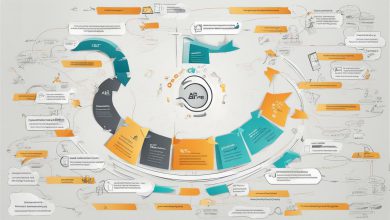
Welcome to our guide on becoming a professional team leader! As you navigate the exciting world of leadership, it’s essential to empower success, both for yourself and your team. In this guide, we’ll explore the qualities and skills necessary to become a successful team leader and how you can cultivate these traits to empower your team to achieve their goals. Let’s dive in!
Key Takeaways:
- Empowering success is crucial to becoming a professional team leader.
- This guide will provide insights into the qualities and skills necessary for effective team leadership.
- By implementing these strategies and tips, you can unlock your leadership potential and drive team success.
Why Aim for Professional Team Leadership?
Becoming a team leader can be a game-changer in your career. It is a role that comes with many benefits you don’t want to miss out on. As a team leader, you get to steer your team in the direction of success, and in doing so, you gain valuable leadership development skills that can propel you to greater heights in your career.
Aside from the career advancement opportunities, leadership development is another advantage of becoming a team leader. When you take up the challenge of leading a team, you develop skills such as effective communication, conflict resolution, problem-solving, and critical thinking which directly translate to better leadership performance.
The role of a team leader is not limited to managing team members but also involves developing strategies that deliver positive business outcomes. Therefore, by becoming a team leader, you also get the chance to sharpen your business acumen skills.
Ultimately, becoming a team leader is not just about enabling success within your team or advancing your career. It is also about investing in yourself and growing both personally and professionally.
Essential Qualities of a Successful Team Leader
Team leadership is a complex and challenging endeavor that requires a unique set of skills and qualities. To be a successful professional team leader, you must possess strong team leadership skills.
Professional Team Leader is someone who has the ability to inspire, motivate and guide individuals towards a common goal. Below are some essential qualities of a successful team leader:
| Qualities | Description |
|---|---|
| Clear Communication | A team leader should be a good communicator who can articulate their ideas and convey their vision in a clear and concise manner. |
| Empathy and Emotional Intelligence | Empathy and emotional intelligence are critical qualities for a professional team leader to possess. The ability to understand and respond to individual team members’ emotions, feedback and needs is vital for building trust and collaboration within the team. |
| Problem-Solving and Decision-Making | A team leader should have strong analytical and problem-solving abilities that allow them to assess challenges, evaluate alternatives, and make decisions that align with the team’s goals |
| Positive Attitude and Resilience | Being a professional team leader is not an easy task, therefore, it’s critical to have a positive attitude and resilience to adapt to changing circumstances and bounce back from setbacks |
Team Leadership Skills
Team leadership demands several core skills that team leaders can use to guide and motivate their team towards achieving set goals and objectives.
- Delegation and task management
- Active Listening
- Encouraging feedback from team members
- Recognizing and rewarding team members’ accomplishments
- Effective problem-solving
- Building trust and collaboration among team members
As a professional team leader, it’s essential to master these skills to ensure that you and your team can work towards the common goal, achieve success and growth.
Developing Leadership Skills
Leadership development is an ongoing process that requires dedication and commitment. Whether you are a seasoned leader or just starting out, there is always room for improvement. Leadership training programs and workshops are a great way to enhance your skills and learn new techniques to effectively lead your team. Here are some practical tips for developing your leadership skills:
| Tip | Explanation |
|---|---|
| Read leadership books | There is a wealth of knowledge available in leadership books. Reading books by successful leaders can provide insights into different leadership styles and techniques that you can apply to your own leadership approach. |
| Find a mentor | Mentors can provide guidance, support, and advice as you navigate your leadership journey. Look for someone who has experience in your industry and is willing to share their insights with you. |
| Attend leadership workshops | Leadership workshops offer a structured approach to learning new skills and techniques. They are facilitated by experts in the field and provide opportunities to practice and apply what you have learned. |
| Solicit feedback | Feedback is a valuable tool for growth and development. Ask your team members and colleagues for feedback on how you can improve your leadership skills. |
Remember, leadership development is not a one-time event but a continuous process. Invest in your growth as a leader by taking advantage of the resources available to you.
Building Effective Teams
As a professional team leader, building an effective team is a crucial aspect of achieving success. Team building skills help you create a positive work environment, improve team collaboration, and resolve conflicts. Here are some practical strategies to help you build and lead an effective team:
1. Hire the Right People
One of the most important steps in building an effective team is hiring the right people. Look for individuals with the necessary skills, experience, and personality traits to fit into your team culture. Conducting thorough interviews, obtaining references, and assessing behavioral competencies can help you make informed hiring decisions.
2. Foster Collaboration
Collaboration is key to achieving success as a team. Encourage open communication, active listening, and mutual respect among team members. Facilitate team-building activities that help foster a sense of belonging and encourage collaboration.
3. Set Clear Expectations
Ensure team members understand their roles and responsibilities by setting clear expectations from the outset. Communicate team goals and objectives, and provide guidelines for how team members should contribute to achieving them. This will help everyone stay focused and motivated while working towards a common goal.
4. Encourage Professional Development
Professional development is a vital aspect of building an effective team. Encourage team members to pursue training opportunities, attend industry events, and continue learning. This will not only help them grow professionally, but also benefit the team by bringing new ideas and perspectives.
Remember, building an effective team takes time and effort. As a professional team leader, it’s your responsibility to create a work environment that fosters collaboration, open communication, and continuous improvement. By following these tips, you’ll be well on your way to building a team that can achieve great things.
Communication and Collaboration
As a professional team leader, effective communication and collaboration are essential skills for driving success. Communicating effectively with your team members promotes clarity, ensures that everyone is on the same page, and fosters trust and respect.
One effective communication strategy is to tailor your message to individual team members. Different people have diverse communication styles, so understanding how your team members prefer to receive information can help you communicate more effectively.
Active listening is another essential skill for effective communication. By actively listening to your team members, you can understand their perspectives, build rapport, and demonstrate that you value their input.
Collaboration is also critical for success as a team leader. Encouraging your team members to collaborate fosters creativity, encourages diverse perspectives, and promotes a sense of ownership and teamwork. Utilizing collaboration tools, such as project management software, can also help your team work more efficiently and effectively.
Remember, effective communication and collaboration as a professional team leader is not just about talking, but also about listening, understanding, and working together towards a common goal.
Setting Goals and Expectations
As a professional team leader, setting clear goals and expectations is a crucial aspect of achieving success. Without a clear vision and direction, your team may struggle to stay focused and motivated.
One effective technique for setting goals is to use the SMART framework. This means ensuring that goals are Specific, Measurable, Achievable, Relevant, and Time-bound. By following these guidelines, you can create goals that are clear, actionable, and aligned with your team’s objectives.
It’s also important to communicate these goals and expectations clearly to your team. Make sure everyone understands their role in achieving the goals and what success looks like. Encourage open communication and collaboration to ensure everyone is on the same page.
Motivating and Inspiring Your Team
As a professional team leader, one of your key responsibilities is to motivate and inspire your team to achieve success. Empowering success is not just about achieving individual goals but also about creating a positive team culture where everyone feels valued and motivated. Here are some strategies to help you become a motivating and inspiring team leader.
Recognize Achievements
Recognizing the achievements of your team members is one of the most effective ways to motivate and inspire them. Take the time to celebrate successes, both big and small, and publicly acknowledge the contributions of your team members. This will not only boost morale but also encourage others to work towards achieving their goals.
Create a Positive Work Environment
A positive work environment is essential for motivating and inspiring your team. Encourage open communication, provide opportunities for personal and professional growth, and recognize the importance of work-life balance. When your team members feel valued and supported, they are more likely to feel motivated and inspired to excel.
Lead by Example
As a team leader, your behavior sets the tone for your team. Lead by example and demonstrate the qualities and behaviors that you expect from your team members. This includes showing up on time, being prepared, communicating clearly, and demonstrating a good work ethic.
Set Challenging but Realistic Goals
Setting challenging but realistic goals is an effective way to motivate and inspire your team. Encourage your team members to stretch themselves and strive for excellence, but also ensure that the goals are achievable and aligned with the team’s overall objectives. This will help to build confidence and encourage a sense of accomplishment.
Remember, motivating and inspiring your team is not a one-time event but an ongoing process. By incorporating these strategies into your leadership style, you can create a positive and empowering work environment where your team can thrive and achieve success.
Handling Challenges and Conflict
As a professional team leader, you may encounter various challenges and conflicts within your team. It is crucial to address these issues promptly to maintain a positive work environment and ensure productivity. Here are some strategies that can help you effectively handle challenges and conflicts:
1. Keep Communication Open
Open communication is key to resolving conflicts within your team. Encourage team members to express their concerns and share their perspective on the issue. Actively listen to their feedback and work together to find a solution that benefits everyone. By keeping communication open, you can prevent minor issues from escalating into major conflicts.
2. Stay Neutral and Objective
As a team leader, it is important to remain neutral and objective during conflict resolution. Avoid taking sides and listen to all perspectives before making a decision. Focus on the issue at hand and the best way to resolve it, rather than personal biases or opinions.
3. Address Conflict Immediately
Ignoring conflict can lead to further issues down the line. Address the conflict as soon as it arises, and take steps to resolve it promptly. This helps prevent a negative impact on team morale and productivity, ensuring that everyone can work together effectively.
4. Learn Conflict Resolution Skills
Conflict resolution is a valuable skill for any professional team leader. Consider investing in conflict resolution training or workshops to enhance your skills and knowledge. This can equip you with the tools and techniques needed to handle conflicts effectively and maintain a positive work environment.
By using these strategies, you can handle challenges and conflicts within your team in a professional and effective manner. Remember that as a team leader, it is your responsibility to maintain a positive work environment that promotes productivity and success.
Continuous Improvement and Feedback
As a professional team leader, continuous learning and improvement are crucial elements of success. To continuously improve, it’s essential to seek feedback from your team members and superiors.
Encourage open communication: Encourage your team members to share their thoughts, ideas, and feedback with you. This will help you gain a better understanding of their perspectives and allow you to make informed decisions. Create an open-door policy and actively listen to your team’s feedback.
Performance evaluations: Regular performance evaluations are an ideal way to provide feedback to team members. Evaluations provide an opportunity to discuss an employee’s performance, goals, and career aspirations. Ensure that you provide specific feedback that highlights areas for improvement and areas where team members excel.
Constructive feedback: Learning how to provide constructive feedback is essential for a professional team leader. When providing feedback, focus on specific behaviors and facts rather than making personal attacks or assumptions. Provide feedback in a timely manner and follow up to ensure that your team members understand and implement the feedback.
Culture of continuous learning: Encourage a culture of continuous learning by providing opportunities for team members to attend training programs, workshops, and conferences. Create a library of resources that your team can access and encourage them to share the knowledge gained with their colleagues.
Continuous improvement and feedback are critical components of professional team leadership. Building a culture that promotes learning and development will empower your team to achieve even greater success.
Conclusion
As we come to the end of this Empowering Success Guide to becoming a Professional Team Leader, it is important to reflect on the key takeaways from this article. Success in leadership roles is not just about managing tasks and people, but about empowering others to reach their full potential.
Throughout this guide, we have explored the essential qualities of a successful team leader, the importance of continuous learning and development, effective communication and collaboration, and strategies for motivating and inspiring your team. We have also provided insights into handling challenges and conflicts and fostering a culture of continuous improvement and feedback.
By implementing the strategies and techniques shared in this guide, you can unlock your leadership potential, foster a positive work environment, and empower your team members to achieve success. Remember, becoming a professional team leader is not a one-time accomplishment but an ongoing journey of growth and development.
Thank you for reading this Empowering Success Guide. We hope this article has provided you with valuable insights and practical tips to help you become a successful professional team leader.
FAQ
Q: What is the purpose of this guide?
A: This guide aims to provide valuable insights and strategies for individuals aspiring to become professional team leaders. It covers essential qualities, skills, and techniques needed to effectively lead teams and drive success.
Q: Who can benefit from this guide?
A: This guide is beneficial for anyone interested in developing their leadership skills and advancing their career as a team leader. It is suitable for both aspiring leaders and current team leaders looking to enhance their abilities.
Q: How can I become a professional team leader?
A: To become a professional team leader, it is important to focus on developing essential qualities such as communication, collaboration, goal-setting, and motivation. This guide provides valuable tips and strategies to help you on your journey.
Q: Are there any specific training programs recommended?
A: While specific training programs may vary depending on your preferences and industry, this guide highlights the importance of continuous learning and offers suggestions for leadership development programs, workshops, and self-study resources.
Q: How can I handle conflicts within my team?
A: Conflict resolution is an essential skill for team leaders. This guide provides strategies for managing conflicts, handling difficult team members, and maintaining productivity during challenging times. It emphasizes the importance of open communication and fostering a positive work environment.
Q: How can I motivate and inspire my team?
A: Motivation and inspiration play a crucial role in empowering team success. This guide offers strategies for motivating team members, recognizing achievements, and creating a positive work environment that fosters growth and collaboration.
Q: Is continuous improvement important in team leadership?
A: Yes, continuous improvement is essential for professional team leadership. This guide emphasizes the significance of continuous learning, performance evaluations, and providing constructive feedback. It encourages the development of a culture of continuous improvement within your team.








